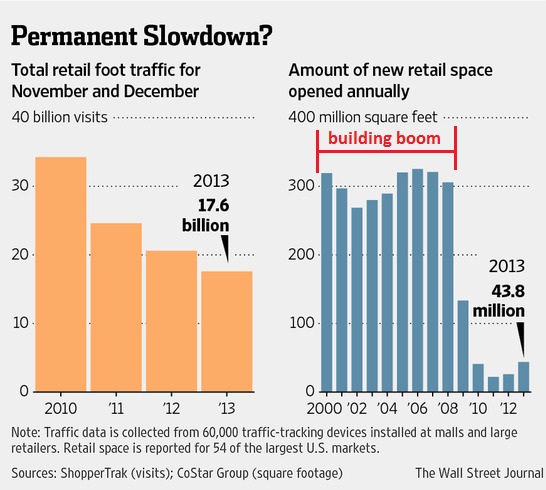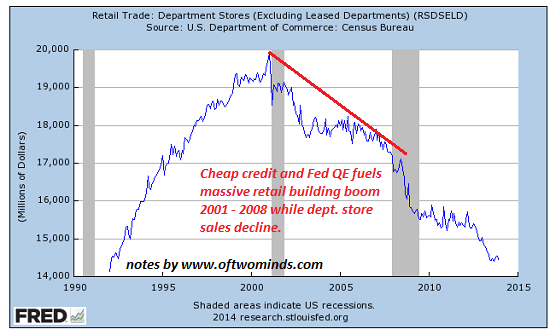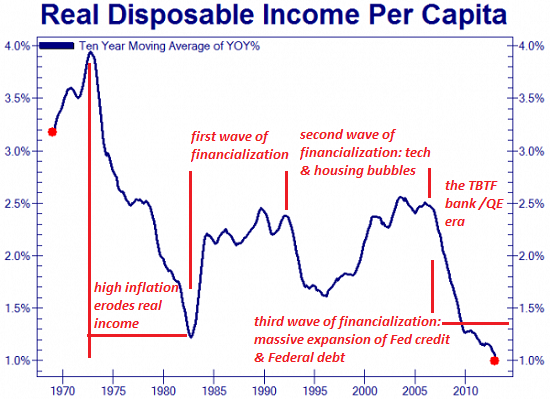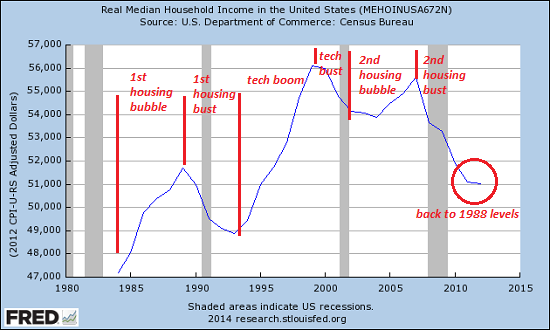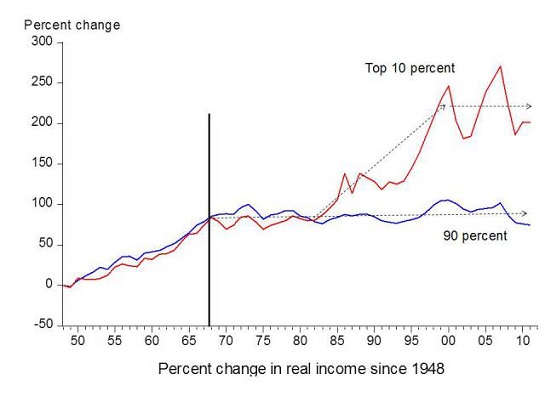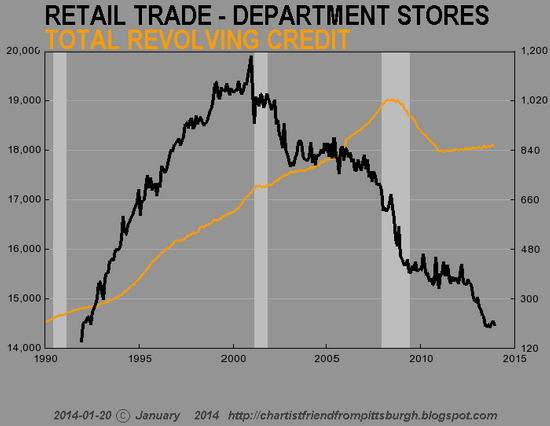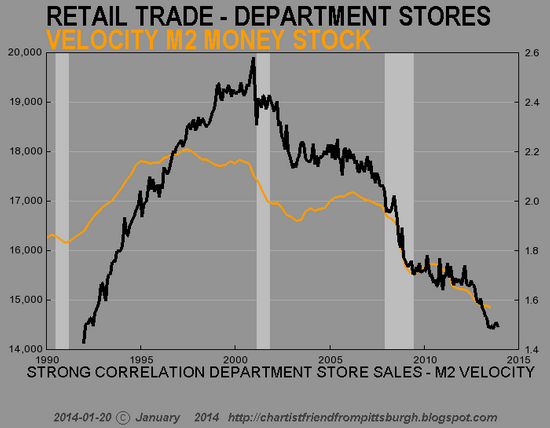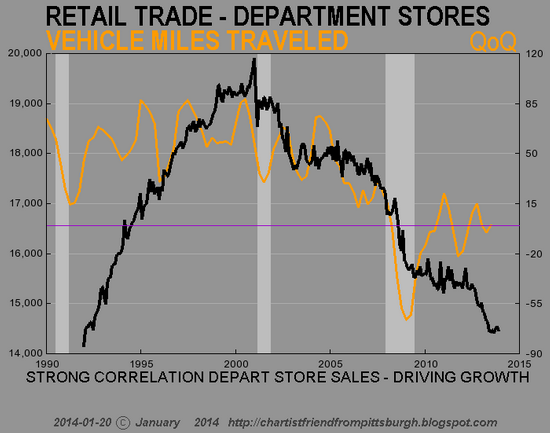Chris Whalen is one of the best bank analysts on the planet. He sees right through the Wall Street/K Street lies and obfuscation. He has analyzed the numbers and concluded that Fannie and Freddie have not generated billions of profits in the last two years. They are losing billions. Accounting fraud does not create profits. These two bloated pigs are insolvent. That is why their stock prices are at $1.50 when they are supposedly generating the highest profits in their history.
Now that Chris has proven they are losing billions rather than making billions, you need to understand the other piece. The $100 billion they have supposedly “paid back” to the Treasury has supposedly “reduced” the Obama deficits. It is untrue. No money was paid. It was an accounting entry based on fraudulent assumptions. The current year deficit is really $100 billion higher than the lies provided by Obama and his minions.
Are Fannie Mae and Freddie Mac Really Profitable? Really?
Submitted by
rcwhalen on 08/22/2013 06:06 -0400
“As force is always on the side of the governed, the governors have nothing to support them but opinion. It is, therefore, on opinion that government is founded; and this maxim extends to the most despotic and the most military governments as well as to the most free and popular.”
— David Hume
Update 1 | So are Fannie Mae and Freddie Mac really profitable? For months now, the GSEs have reported rising current profits, an amazing rebound that has caused the hopes of many members of Congress to likewise elevate. The financial press has been filled with hopeful stories to the effect that the zombie dance queens may actually dig their way out of a several hundred billion dollar hole they created during the subprime crisis.
But now a report released earlier this week by the Federal Housing Finance Agency’s Inspector General raises new concerns. Specifically, the IG asks why Fannie Mae, Freddie Mac and the Federal Home Loan Banks have been dragging their feet implementing 2012 accounting changes that would accelerate the timing of tens of billions of dollars of unrealized losses on bad loans from the uber toxic 2004-2008 period. The IG report states:
“The advisory bulletin directed the enterprises and the Federal Home Loan Banks (FHLBanks) to classify any outstanding loan balance in excess of the fair value of the property, less cost to sell, as “Loss” when the loan is no more than 180 days delinquent. The issue was identified by FHF A examination staff during the course of a credit examination of Freddie Mac completed in January 2012. The advisory bulletin’s background section provided the following rationale: The purpose of this guidance is to establish a standard and uniform methodology for classifying assets of the Enterprises and the FHLBanks based on the credit quality of the assets. The classification of assets is a critical element in evaluating the risk profile and the adequacy of capital, loan loss reserves, and earnings.”
Thus the question: Have the GSEs really set aside proper reserves given that they do not have to charge-off loans that are 180 days or more delinquent until January 2015? Well, sort of – at least based on the bad loans shown on the respective balance sheets. I have asked various officials of that world class regulator, the Federal Housing Finance Administration, this precise question for years now. The answer has always been yes, we are adequately reserved. Here’s the official view from FNM:
“The guidance FHFA has issued would change our methodology for charging off loans, but would not materially change our results.”
Is this really true? After years, no, really decades of obfuscation and outright mendacity, are the folks at Fannie Mae and Freddie Mac really telling us the truth now about their financial condition? Washington is a city of lies, let us remember, with a good part of the population paid to disseminate falsities as part of their job description. But the biggest lie of all was allowing the GSEs to avoid marking their impaired assets down to fair value as commercial banks are required to do. Had this been done, the losses reported by the enterprises would have been far larger.
Let’s walk through the accounting first and then draw some conclusions. We’ll focus on Fannie Mae (FNM) to make the narrative easier to follow. Let’s refer to the form 10-Q filed by Fannie Mae for Q2 2013. And, by the way, the “material” test is with what information investors need to know to make an informed investment decision, not what is material in terms of the company’s operations or investor relations objectives.
First we start with Page 96 in the notes to the consolidated financial statements. As of June 30, 2013, FNM had about $140 billion in total delinquent loans on its balance sheet, including about $80 billion in the “seriously delinquent” category. Good guess for loss given default on this subset of bad paper is well north of the high 20% rates that FNM is reporting on current disposals and the 40% loss severity rates we hear discussed in polite society. One particular RMBS veteran thinks the severity on the 04-08 vintage is more like 60-70% because so much of the underlying collateral remains under water. The remaining delinquent loans total about $60 billion. FNM has about $50 billion in reserves set aside to cover losses on these bad loans and other assets.
To put these numbers in context, FNM reported $10 billion in income in Q2 2013 before paying more than that amount to the US Treasury in a dividend, leaving the enterprise with a GAAP loss. If you ignore the effect of tax assets, which pushed income up by $40 billion in 1Q 2013, $10 billion per quarter is a reasonable run rate for FNM income. The fact that FNM has not needed to expend loss reserves, which are an off balance sheet item, to clean up its balance sheet is very significant and explains part of the GSE’s current profitability.
Unlike a commercial bank which must generally charge off a bad loan (either entirely or at least down to recovery or “fair value”) once it goes beyond 90 days past due, the GSEs actually book bad loans at “cost,” plus accrued interest. So, for example, when a GSE repurchases a bad loan from an RMBS trust, at par plus accrued interest, the loan is then booked and carried at “cost” until the loan is liquidated.
Once you understand the bizarre accounting for loan and real estate owned (REO) losses used by the GSEs you can see why the effect of the advisory bulletin has some investors a bit concerned. As with Jesse Jones in the 1930s, time is our friend. But now just imagine you are one of those generous souls led by that Wall Street titan and philanthropist John Paulson who are suing the GSEs based on the assumption that they are truly profitable. But I digress.
Footnote one on Page 96 the 10-Q illustrates the idiocy of GSE accounting, defining the “recorded investment” of some $95 billion in non-accrual loans as consisting “of unpaid principal balance, unamortized premiums, discounts and other cost basis adjustments, and accrued interest receivable.” Or put another way, of the $140 billion in total delinquent loans at June 30, 2013 — loans which are carried at 100% of their original value, plus accrued interest — FNM is essentially pretending that 60% of that amount represents an “investment.” Hold that thought.
So if FNM was to immediately implement the new accounting rules put in place in 2012, the question is what losses would be applied to the $140 billion? Looking at the loss severities for FNM loans bandied about by analysts, a haircut of about 40% would seem like a good point of departure. But let’s instead go back to the figures as the top of this piece. If we put a 60-70% loss severity on that $80 billion in seriously delinquent loans, we are talking ~ $50 billion right there. Take half that rate – 30-35% loss given default — on the remaining delinquent loans and we get another ~ $20 billion or $70 billion or so in total charge offs against reserves.
Why the divergence from current FNM loss severities in the estimates? Because, as is axiomatic, the better loans and REO assets with lower losses tend to get sold first. To be conservative, in keeping with the FHFA guidance, a more severe haircut is appropriate. If the loss severities turn out to be lower, then the enterprise can book a recovery to loss reserves, which will positively affect income.
So if we were to implement the guidance from FHFA today, it is pretty clear that the profits of the GSEs would have been largely offset by the allocations needed to replenish the reserves. If we use the income figures from the FNM 10-Q, all of the “profits” from 2012 and the first half of 2013 would disappear, and then some. Reserves of $54 billion would be consumed and another $10-20 billion would need to be immediately allocated from income to cover the balance. Treasury would need to replace this deficit to avoid seeing FNM operating insolvent. Just for giggles, compare this adjustment to the $1.6 billion in charge-offs taken by FNM in Q2 2013 under the current rules.
FNM would then need to retain income to replenish reserves for future losses, but fortunately loss rates on new production are far lower than during the awful 2004-2008 period. Arguably a reserve buffer of $25-30 billion or half of current reserves would be a reasonable starting point for the “new,” post crisis FNM. Some may differ with my view on loss severities, but for an investor in FNM, a $60-70 billion unrealized loan loss certainly seems material to me.
But this is not the end of the analysis. In addition to loans, FNM and Freddie Mac have significant amounts of single family and multifamily real estate – 96,000 REO assets in the industry parlance – that was taken over from a debt previously contracted. Losses from foreclosed properties, for example, totaled over $300 million in Q2 2013 under existing rules. FNM currently shows about $10 billion in REO on balance sheet under “acquired property” or an average of about $96,000 per property. On Page 24 of the FNM 10-Q, the enterprise discusses recent experience disposing of REO:
“Sales prices on dispositions of our REO properties improved in the second quarter and first half of 2013 as a result of strong demand compared with the prior year. We received net proceeds from our REO sales equal to 68% of the loans’ unpaid principal balance in the second quarter of 2013 compared with 59% in the second quarter of 2012 and 66% in the first half of 2013 compared with 58% in the first half of 2012. The increase in sales prices contributed to a reduction in the single-family initial charge-off severity rate to 24.93% for the second quarter of 2013 from 30.59% for the second quarter of 2012, and to 26.09% for the first half of 2013 from 32.07% for the first half of 2012. The decrease in our charge-off severity rate indicates a lower amount of credit loss at foreclosure and, accordingly, a lower provision for credit losses.”
The sales discounts from the unpaid principal balance or “UPB” described above are pretty low compared to what has been going on in the real estate market generally. In many parts of the US, the spread differential between REO and voluntary sales has disappeared, yet the fact remains that there are many home owners in the US that are still underwater. Remembering the high preponderance of 2004-2008 exposure in the FNM book, that 25% loss experience on REO liquidations in 2Q 2013 seems miraculous.
Going back to the loss severities seen in whole loans, the experience with REO sales certainly shows improvement but we must remember that the homes are carried at “cost” as with whole loans. If we take 25-30% discounts to UPB as a point of departure, we probably ought to think of a 40-50% discount on the entire portfolio of REO properties in the FNM portfolio to comply with the FHFA guidance. Call it $4-5 billion on the REO book. Again, this mark may be conservative, but FNM can take any future gains above the new “fair value” marks as recoveries to reduce future reserve contributions and enhance income. The charge-off should be sufficient to ensure that any future adjustment is in favor of FNM and the US Treasury.
Not only does FNM seem to be unprofitable under the new FHFA guidance, but payments made to Treasury might need to be reversed. Tens of billions in capital injections would be required in order to fund the write-down of FNM’s bad loans and replenish reserves for future loss, creating yet another twist for both markets and investors to consider. Since under the second preferred stock agreement between Treasury and FNM the US government confiscates the net income of the enterprise, there is nothing left to buffer FNM against future loss.
Ultimately neither the Obama Treasury nor members of Congress want to get into this mess before the 2014 election, but suffice to say that it is incorrect to claim that either FNM or Freddie Mac are profitable. The final twist comes from the big question, IMHO, namely how much further loss will be uncovered if Congress ever summons the courage to wind down the zombie dance queens.
Given the above analysis, a strong case can still be made that FNM and Freddie Mac ought to be moved to receivership and liquidated. This process would extinguish the supposed claims by “investors” like John Paulson and move the assets of the GSEs into private hands as quickly as possible. But that would be the good news. A prompt resolution of both enterprises would generate growth, income and jobs – something nobody in Washington understands. But we ought to ask, perhaps in a future rant, just why the FHFA IG office decided to make a fuss now, no doubt at the instigation of the US Treasury and Obama White House.











